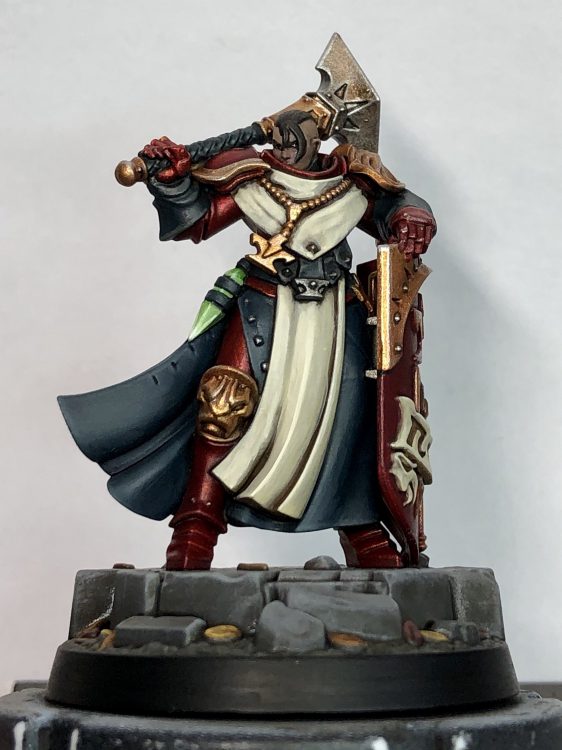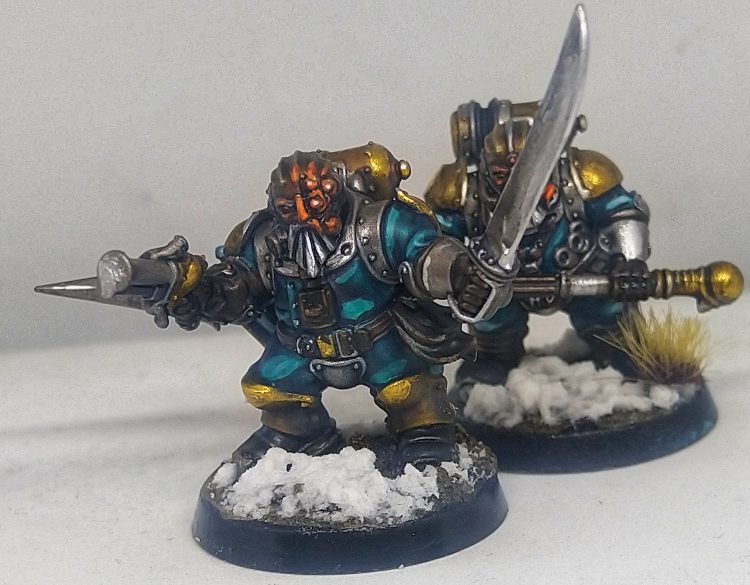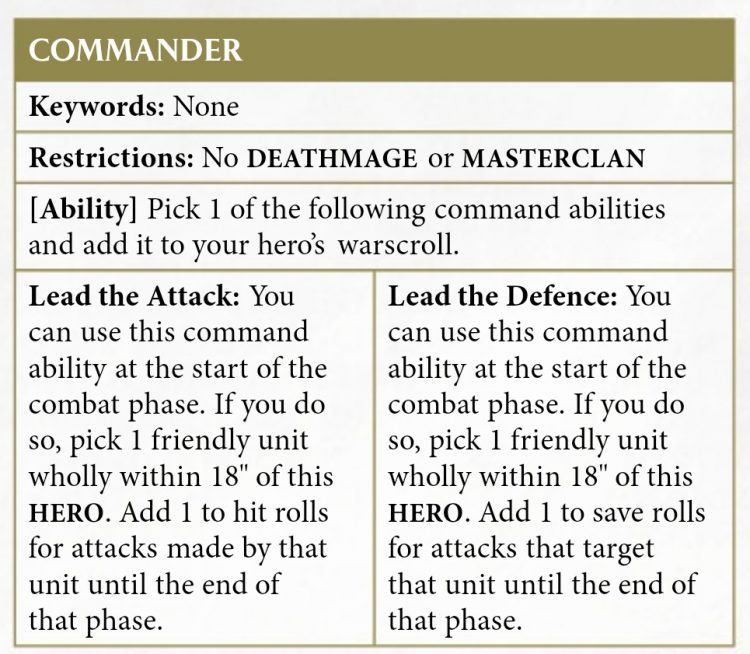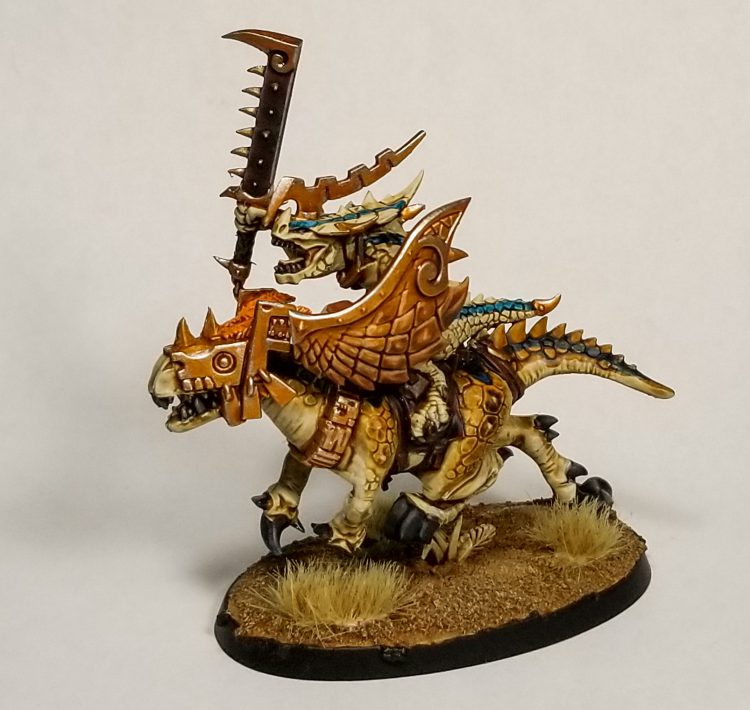Here at the Age of Sigmar department in the Goonhammer offices we’re a bit baffled by all the loud noises coming from the 40k team. No idea what’s got them all so excited, probably a new type of bolter or something. Anyway, we’ll carry on with our look at the biggest Games Workshop release this year – the General’s Handbook.
This week we’ll be looking at the Anvil of Apotheosis. RagnarokAngel is especially excited about this one.
RagnarokAngel: Personally this has been something I wanted to see in a Games Workshop product for a long time. I came to wargaming from Tabletop RPGs and never really left that mindset. I always wanted a way to come up with a general that was a custom character and use them on the table; GW used to do this kind of stuff in the past, when there were more equipment and upgrade options, but as things became more streamlined and rigid that sort of thing drifted away. I’m glad to see it back.
The Concept

The Anvil of Apotheosis is a new idea introduced in this year’s General’s Handbook. It allows you to create your own character, using a series of tables. This is designed to be used in Campaign Games, Open Play games (with your opponent’s permission) and, interestingly, Matched Play (with the tournament organiser’s permission). We’re not sure how often, if ever, this will be used in tournaments but it would be nice to see, particularly in tournaments with a narrative bent.
It follows these steps:
- Set a destiny point limit for your hero – Basically, how powerful are they supposed to be?
- Choose your ancestry – There are 20 different ancestries which help them cover just about every species in the game world, from Skinks to Bullgors, you have a breadth of options.
- Equip weapons – The weapons are generic, listing things from staves, to bows and swords with the hit/wound/damage mapped out for you.
- Pick an archetype – There are only 3 which does feel sort of limiting, but it does hit the major archetypes.
- Choose a bestial companion (if you want) – Everything from a minor familiar to a giant dragon mount.
- Spend your remaining destiny points – There are a couple of options here for upgrades that didn’t fit anywhere else.
Step 1 – Destiny Points

The easy bit. Here you decide whether you want your hero to be a Champion (with a limit of 20 Destiny Points) or a Conqueror (with a limit of 40). In theory there’s no real cap here if your opponent wanted to allow it, but they likely needed to set a limit for the sake of some sort of balance.
This is then reflected in the points value of the model in Matched Play – the total number of destiny points you spent, multiplied by 10.
Step 2 – Pick Ancestries

There is a list of 23 different Ancestries in the book to pick from (we presume that this will be added to in the future). Each ancestry costs a certain number of Destiny Points and sets your basic stats and keywords. All of them have the HERO keyword and some have the <ARMY> keyword with a list of options.
The list is
- Aelf – ORDER, AELF, <ARMY> (Daughters of Khaine, Idoneth Deepkin, Lumineth Realmlords, Cities of Sigmar) – DP 3
- Bonesplitter Oruk – DESTRUCTION, ORRUK, ORRUK WARCLANS, BONESPLITTERZ – DP 3
- Bullgor – CHAOS, BEASTS OF CHAOS, WARHERD, BULLGOR – DP 8
- Daemon – CHAOS, DAEMON, <ARMY> (Khorne, Tzeentch, Nurgle, Slaanesh) – DP 5
- Deathmage – DEATH, DEATHMAGE (Can be selected as part of the Grand Host of Nagash, Legion of Sacrament, Legion of Blood, Legion of Night) – DP 3
- Dragon Ogor – CHAOS, BEASTS OF CHAOS, THUNDERSCORN, DRAGON OGOR – 10DP
- Duardin – ORDER, DUARDIN, <ARMY> (Cities of Sigmar, Fireslayers, Kharadron Overlords) – DP 4
- Gor – CHAOS, GOR, BRAYHERD, <ARMY> (Beasts of Chaos, Tzeentch) – DP 3
- Grot – DESTRUCTION, GROT, GLOOMSPITE GITZ, <ARMY> (Moonclan, Spiderfang) – DP 3
- Human – ORDER, HUMAN, CITIES OF SIGMAR – DP 4
- Ironjaw Orruk – DESTRUCTION, ORRUK, ORRUK WARCLANS, IRONJAWZ – DP 5
- Malignant – DEATH, MALIGNANT, NIGHTHAUNT (Comes with Fly and Ethereal abilities) – DP 12
- Mordant – DEATH, MORDANT, FLESH-EATER COURTS – 6DP
- Mortal – CHAOS, MORTAL, <ARMY> (Khorne, Tzeentch, Nurgle, Slaanesh, Slaves to Darkness) – DP 4
- Ogor – DESTRUCTION, OGOR, OGOR MAWTRIBES, <ARMY> (Beastclaw Raiders, Gutbusters) – DP 7
- Ossiarch Bonereaper – DEATH, OSSIARCH BONEREAPERS – DP 5
- Saurus – ORDER, SERAPHON, SAURUS – DP 6
- Skaven – CHAOS, SKAVEN, SKAVENTIDE, <ARMY> (Masterclan, Clan Pestilens, Nurgle, Clans Verminus, Clans Skyre, Clans Moulder, Clans Eshin) – DP 3
- Skeleton – DEATH, SKELETON, DEATHRATTLE (Can be selected as part of the Grand Host of Nagash, Legion of Sacrament, Legion of Blood, Legion of Night) – DP 3
- Skink – ORDER, SERAPHON, SKINK – DP 4
- Stormcast Eternal – ORDER, CELESTIAL, HUMAN, STORMCAST ETERNALS – DP 5
- Sylvaneth – ORDER, SYLVANETH – DP 4
- Vampire – DEATH, VAMPIRE, SOULBLIGHT (Can be selected as part of the Grand Host of Nagash, Legion of Sacrament, Legion of Blood, Legion of Night) – DP 4
As you can see it covers most species in Age of Sigmar. Each ancestry comes with a preset number of wounds, bravery, movement and saves. Don’t worry, you can change these later. For example let’s look at if we wanted to make one of Sigmar’s Golden Boys, what do we have to work with?

Not a bad statline. Makes sense why they cost a quarter of the minimum points.
Step 3 – The Armoury

Here you pick the weapons your hero is armed with. They get to choose one of the following sets of options:
- 1 one-handed melee weapon
- 2 one-handed melee weapons
- 1 one-handed melee weapon and a shield (Malignants can’t take this)
- 1 two-handed melee weapon
- 1 handbow and 1 one handed melee weapon
- 1 bow and 1 one handed melee weapon
Each weapon comes with the stats as well as a Destiny Point cost. Most of them cost 1DP although some of the more powerful two handed weapons cost 2. There’s also the choice to take an improvised weapon for 0 DP. As a glimpse into the one handed weapons options, lets look at the table:

Pretty varied list, and a lot more if you prefer a two handed variety. The generic weapons again function as a baseline; you have options further in the creation process to strength them. Also, despite the very generic names you’re encouraged to rename them as you wish. For our prospective Sigmarine let’s give them a Hammer, as befits Sigmar, and a handbow for ranged options. At 2 DP a piece we’re now at 7 including our 5 DP base.
Step 4 – Archetypes

Now you get to pick one archetype from a list of 3. Each one comes with various abilities and some have restrictions on them
Commander
These are the standard heroes and can be picked by anyone other than a Masterclan or Deathmage. When you pick this you get to choose between two abilities
- Lead the Attack – +1 to hit rolls for a unit within 18″ in the Combat Phase
- Lead the Defence – +1 to saves for a unit within 18″ in the Combat Phase

Acolyte
This is the Priest archetype and grants the model that keyword. It’s restricted to everyone but Daemons, Deathmages, Saurus or Skaven (although Clans Pestilens are allowed).
You get to choose between two prayers that you can cast in the Hero phase on a 3+
- Wrathful Invocation – D3 Mortal wounds to a unit within 18″
- Shield of Faith – 6+ wound save to a unit within 12″
Mage
Gains the Wizard Keyword. Can’t be taken by Duardin, Khorne or Saurus. They get to choose 1 spell from the table provided and get to unbind once. They also know Arcane Bolt and Mystic Shield, as usual.
- Aura of Protection – Casting Value 7 – 6+ wound save on all units within 7″ of the Caster.
- Curse of Damnation – Casting Value 7 – D3 Mortal wounds to a unit within 12″. Also subtract 1 from save rolls for that unit until your next hero phase.
- Wildfire – Casting Value 6 – Pick an enemy unit within 12″ and roll a dice for each model, doing a mortal wound on a 5+. Roll 3 dice if it’s only one model.
- Raise Dead – Return D3 wounds worth of models to a unit within 12″.
As befitting a Warrior of Sigmar I figure we can make them a Champion. He will choose Lead the Attack as is fitting. He is still at 7 points, since archetypes cost no DP.
Step 5 – Bestial Companion

Here you get to pick from 3 levels of Bestial companions (or none at all). Each costs a number of Destiny Points and comes with the relevant stats as well as an enhancement.
- Minor Beast – +1 to your hero’s wounds – DP 6
- Mounted Beast (no Bullgor or Dragon Ogor) – +2 to your hero’s wounds and grants movement of 8″ – DP 8. These are generic enough to represent a variety of mounted beasts of roughly horse size. Anything from Gryph-chargers to boars can fall under here.
- Gargantuan Beast (no Bullgor or Dragon Ogor) – +8 to your hero’s wounds and grants a movement value from a table (decreasing as wounds are taken) – DP 15. These represent giant creatures from zombie dragons to thundertusks. If it has a decreasing statline, it probably falls under here. The significant cost pretty much limits it solely to 40 DP characters.

Back to our Hypothetical Stormcast, if we want to give him a Gryph-charger let’s put this stat block in, giving him a Wound characteristic of 7 and movement of 8. We’re at 15 DP spent now.
You then get to give one of the following traits to them
- Winged Beast – Can Fly (no Minor Beasts) – DP 4
- Breath Attack – In the shooting phase pick an enemy unit within 6″ and roll a dice, causing a mortal wound for every 6+ (Gargantuan Beasts only) – DP 4
- Vicious Charge – After you charge succesfully roll a dice and on a 2+ do D3 mortal wounds to an enemy you’re within 1″ of – DP 1
- Razor-sharp Claws – Improve the bestial companion’s rend by 1 – DP 2
- Poisonous Bite – Unmodified hit rolls of 6 do a mortal wound – DP 2
- Gobble Attack – After you have resolved your attacks pick an enemy model within 1″ and roll a dice, the model is slain if it’s above the wounds characteristics (Gargantuan Beast only) – DP 3
- Terror – -1 Bravery to enemies within 3″ (Gargantuan Beast only) – DP 1
- Savage Frenzy – +1 attacks to the beasts Claws or Maw and 1 to the damage – DP 1
- Lashing Tail – At the end of combat roll a dice for each enemy unit within 3″ and do D3 mortal wounds if it’s less than the models left alive (Gargantuan Beast only) – DP 3
- Savage Ferocity – +1 to hit for the Claws or Maw – DP 1
- Savage Strength – +1 to wound for the Claws or Maw – DP 1
- Stomp – At the end of the combat phase pick an enemy unit within 1″ and on a 2+ it suffers D3 mortal wounds (Gargantuan Beast only) – DP 2

We wanted to give our hypothetical warrior of Sigmar a mount right? Well as a Gryph Charger it has to fly so let’s give it the fly option, we’ve spent 19 points, so we have one left over.
Characteristic Enhancements and Abilities
The finishing touches, if you have any points left, allow you to give your character stats boosts and unique abilities. The list includes:
- Superior Speed – Increase move characteristic by 1″ – DP 2
- Superior Vitality – Increase wound characteristic by 1 – DP 1
- Superior Leadership – Increase Bravery by 1 – DP 1
- Extra Armor – Improve Heroes’ Save Characteristic by 1 (To a maximum of 3+) – DP 2
- Mighty Weapon – Pick a weapon (not counting mount weapons) and increase damage by 1 – DP 2
- Sharpened Edge – Pick a weapon and improve rend characteristic by 1 (to a maximum of -3) – DP 2
- Ethereal – Ignore modifier to saves (positive or negative) – DP 4
- Ward – 6+ FNP save – DP 3
- Fly – The model can fly – DP 4
- Frenzy – When you roll a 6 to hit, score two hits instead of 1 – DP 3
- Regenerate – Roll a die in the hero phase and on a 4+ heal D3 wounds – DP 3
- Battle Standard Bearer – Hero gains the TOTEM keyboard – DP 1
- Inspiring – While friendly models are within 12″ they can use the Hero’s bravery characteristic instead of their own. If they have the TOTEM keyboard its increased to 18″ – DP 1
- Weapon Master- Pick a Hero’s weapon and improve to hit by 1 – DP 2
- Superior Strength – Pick a Hero’s weapon and improve to wound by 1 – DP 2
- Ferocity – Pick a hero’s weapon and improve Attack characteristics by 1 – DP 3
- Consummate Commander – Receive a CP each battle round if the Hero is on the field – DP 5
- Archmage – Add 1 to casting rolls (Wizards only) – DP 3
- Arch-Priest – Add 1 to prayer rolls – DP 3
- Zealot – This model can run and charge in the same turn.
- Decapitating Strike – On an unmodified wound roll of 6 with melee weapons, deal a mortal wound in addition to normal wounds. DP 4
- Deadeye – On an unmodified wound roll of 6 with ranged weapons, deal a mortal wound in addition to normal wounds. DP 4
For our Stormcast we only have 1 DP left, so might as well throw a wound on him, giving him a total of 8. Pretty solid, we could certainly do better if we upped the cap to 40, or took him off his mount. There’s a lot of potential variety of options, even if they are pretty generic on the surface.
Conclusion
I think that this is all a solid foundation. A lot of the abilities are very generic and based off of commonly seen abilities. You’re encouraged to fluff them up, giving them unique names or using the attribute adjustments to make the character your own. As much as I’d like to see more wild, out there abilities that probably was never going to happen, as they needed to create a framework to allow a somewhat balanced option.
Is it potentially open to exploitation? Absolutely. That’s why it will never see play in a “real” tournament. Every army would likely be filled with the same 2-3 builds that have been min-maxed. That’s not what this is for, it’s for allowing you to create your own characters, either ones you’ve created in battle reports, Soulbound Campaign settings, or fan fiction to be unique players on the table rather than generic clones of pre-existing ones, and it’s suited to the kind of events that would support that – narrative-focused campaign weekends or similar, perhaps with comp in place to limit the builds a little.
What kind of characters will you be making? We’d love to see them, and their accompanying models – contact us on social media or contact@goonhammer.com.


